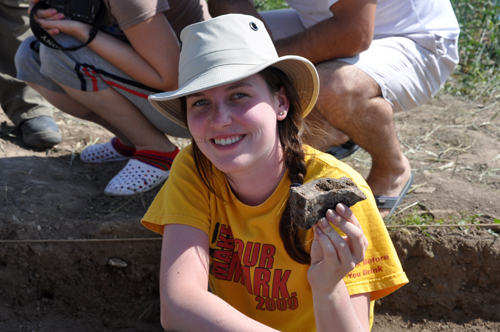
When you go on a dig with languages and literatures professor Andrew Sherwood, you never know what you’ll discover.
One thing you might find: a different way of life. “Our group flew into Romania’s largest city, filled with beautiful architecture and parks,” says Sherwood, who has led groups of students to work on archeological digs in many parts of the world.
“Then we rode a bus for two-and-a-half hours. When we pulled into the town where we’d be based, there was a woman coming towards us in a cart pulled by a donkey. It seemed that at least half the people in the town used horse- or donkey-drawn carts for transportation.” At first, the students would notice the amenities that were missing, but within a few days, Sherwood says, they found it relaxing to live this simpler life.
You might discover pottery and artifacts that have been buried for centuries, as each of the seven U of G students or alumni on this expedition did. The site where they worked on the edge of the Black Sea in Romania was just outside an ancient town that had been called Orgame when it was a Greek colony in 700 BC, then Argamum when the Romans took over.
“A hero cult began when an important person died – perhaps the town’s founder – and a cult structure was set up outside the city,” explains Sherwood. Later, further from the city, a second sanctuary seems to have been set up for another hero, who might have been a woman. Sherwood points out that the people who lived in the later town were the ancestors of Cleopatra and powerful, accomplished women are frequently mentioned in the historical records.
The dig was supervised by Prof. Vasilica Lungu from the Institute of Archaeology Vasile Parvan of Bucharest. Sherwood’s students worked in two areas: in one, they found a small building set up for farm workers dating from between the fifth and seventh century AD; the other, on the edge of the area where the later sanctuary had been built, included a basilica, a Roman-designed structure often used in early Christian churches.

One student found a solid metal hammer head in perfect condition; others found pottery that helped to date the structure and one found human teeth. “I was pleased that each student discovered an artifact of some importance,” says Sherwood.
But the most interesting thing you might discover is something unexpected, as these students did. Right in front of the apse inside the basilica was a shaft, built with quarried blocks, which descended three metres into the ground and connected to a tunnel that headed south. At the end of the tunnel, another shaft led up to the surface in an open field, again made of quarried stone. The first shaft had built-in hand-holds and foot-holds so that people could climb up and down. “They have lasted at least 2,300 years and they are absolutely solid,” says Sherwood.
What would these shafts and tunnel have been used for? Sherwood suggests that it might originally have been associated with the hero cult that grew up around the heroic figure for whom the sanctuary had been built. People might have made offerings at one opening, while someone climbed down the shaft that was outside the temple area, crept along the tunnel and announced prophecies. Why had it been incorporated into the Christian church building? The answer to that question isn’t so clear.
Whatever its purpose, the tunnel did give students what they called an “Indiana Jones moment.” As Sherwood explains, the stone-walled tunnel was one of the coolest places in the area, and snakes seeking to get away from the hot sun would shelter there. “There were five or six good-sized snakes down there at any one time,” he says. “Of course, after it was uncovered, the students all wanted to go down and see what the tunnel was like. It was a bit of a shock when they discovered the snakes.”
While a tunnel full of snakes certainly qualifies as interesting, Sherwood and his students made another unexpected discovery, this one about the warmth and friendliness of the Romanian people. “One of our students missed her graduation party to be at the dig,” he says. “We planned a little party and asked everyone to sign a card. When the Romanians we were working with found out, they went all out. They made a mortarboard for her to wear, arranged for Romanian graduation music, and even persuaded the mayor of the town to come and present her with an ancient tile for her graduation.”
They also took the student group to visit local sites, including Dracula’s castle, medieval towns and the palace of Romania’s former royal family. When one museum was closed at the time the group arrived, their Romanian friends didn’t hesitate: they got on the phone and called until someone was found to open the doors and give them a tour.
Working on a dig is hard and often boring, but that didn’t dampen the students’ enthusiasm. The experience of discovering and actually holding objects that no one has seen for 2,000 years is a powerful one. Living simply has benefits too: “Good food, fresh air and hard work do you a world of good,” says Sherwood.
He’s already making plans for new discoveries when he works on another dig in Turkey next year in a city established by Roman general Pompey the Great in 64 BC; this time he’ll be going solo because of security challenges. Sherwood can’t wait: “I haven’t been to Turkey for several years and I love it there.”